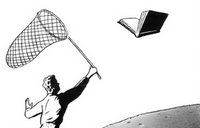
“Reverberators focus on echoes and patterns, finding similarities between what they are now reading and what the have already read, scene or done. A reverberator would read “Oranges,” for example, and think about how the situation is similar to that of Victor in “Seventh Grade” as well as that of Rudy in Novio Boy. A reverberator would also think about other books or films or TV shows that show guys falling in love and about the people in their own lives who have gone through those early stages of forming a relationship with someone.”
If you have been chosen as your group’s reverberator, then your responsibility is to find the connections within the text. Without confusing the issue any more, a reverberator is simply that, someone who makes connections. Whether it is text to world, text to self, or text to text, these connections “echo” throughout most of the writings of Gary Soto. That is, when you read Gary Soto, the first thing that should come to mind are the patterns that Gary Soto uses. Within these patterns (see previous post on patterns) you will find some of the connections between the various writings of Soto.
But do these connections have to be on the writing of Gary Soto, or can they be from other sources as well? Yes, they can be from other sources too. For example, if you can "connect" to a movie that you saw the other day, then yes, that would be a connection. But remember, just because you might have something in common with a character, or seen something similar in the movies, that does not, necessarily, make it a connection. It is only a connection if it helps you to understand/relate to that text.
Let me give you an example: Just because the main character of a story has a cat and you have a cat, that does not necessarily make it a text to self connection. You need to be able to relate to that main character through your cat. Does the cat help you to understand what the main character is feeling? If you answered yes to that question, then yes, it is a text to self connection. Otherwise you need to keep on looking.




